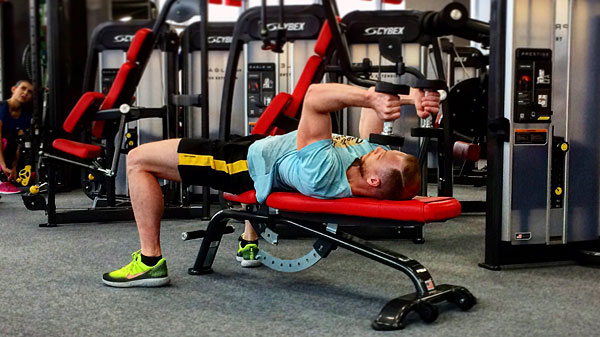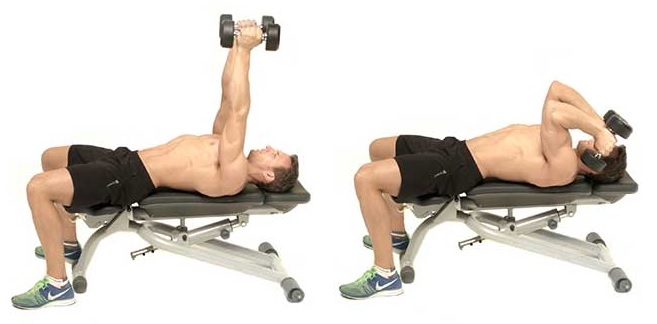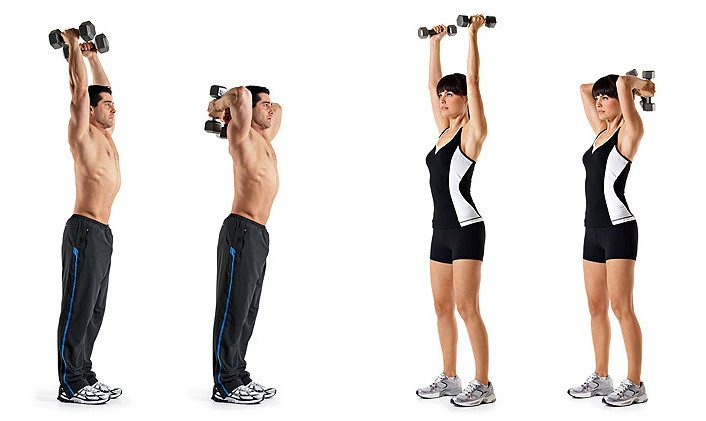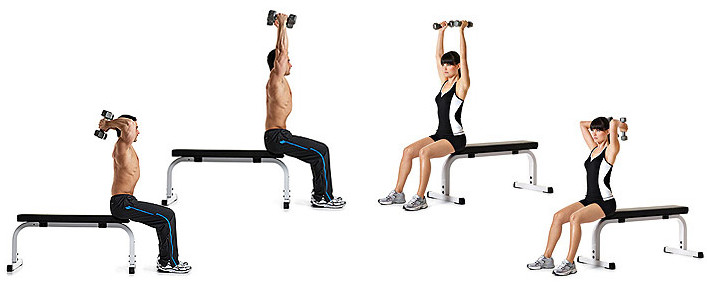
How to do French press with dumbbells standing, sitting and lying
The triceps, otherwise – the triceps arm muscle, perform the flexion-extensor role. Just because of the triceps, the size of the hand is formed. Triceps takes little part in working in everyday life, even with increased physical activity, but at the same time constitutes a large part of the volume of the hand. To develop it, you need special work on this particular muscle. The best isolating exercise for this is the French press. The isolating exercise is called because the load falls on one muscle, the rest of the work is isolated.
Pumping triceps is important if you want powerful handsome hands. Only the biceps are not enough.
Content
- 1French bench press with dumbbells
- 2French press with standing dumbbells
- 3French bench press with dumbbells
- 4Number of approaches and repetitions
- 5Frequent errors: how to avoid them
The French press gives a load on the triceps and is performed with:
- rod,
- dumbbells
- EZ-neck
- other weighting options
The technique of execution is the same
The variant with the bar will feel and work out all the tendons and ligaments of the triceps muscle. French press with dumbbells does not give the maximum load and is performed by a neutral grip, physiological for a person, and not loading hands.
Exercise with dumbbells can also be called pulling dumbbells from behind the head, or press dumbbells from behind the head.
The French bench press with dumbbells is a specific exercise, you need to watch it very carefully so that the technique of its execution is observed: moving, bending at the elbow, only the forearms, the remaining parts of the body remain static.
French bench press with dumbbells
French bench press with dumbbells is preferable for athletes during the build-up period. With this embodiment, the operating time of the power period is maintained. Athletes who have a short triceps and are attached above the elbow prefer the horizontal position digestible carbohydrates for the exercise. It allows you to maximally isolate the triceps. In this case, the elbow is in an unnatural position and assumes a heavy load. This is suitable for those who already work with a lot of weight.
Involved muscles
During the exercise of lying, the force of inertia is excluded, all the heads of the triceps muscle participate in the work. However, the short head in comparison with others has a smaller share of the load. The work of the triceps is isolated, only the elbow joint participates, the rest remain immobile. The effect of exercise – increasing the volume of the hand by increasing the lateral and long heads. Components of the triceps: the lateral, long, and medial heads are shown in the figure below.

Technique of execution
- Perform bench press lying horizontally on the bench (you can straighten the slanted bench) or on the floor.
- We put dumbbells on our knees, we lay down and raise dumbbells above ourselves. Make sure that you have taken the weight for you (with which you can make 10-12 approaches). If there is a partner, he can give dumbbells when you are already lying. Dumbbells should be fed one by one.
- The starting position assumes the position of the elbows is not vertical, but slightly inclined toward the head, which ensures maximum tension of the triceps.
- When lowering the dumbbells are near the shoulder joints on both sides of the head closer to the ears. We lower on inspiration.
- Elbows are fixed during the whole exercise and do not go sideways or back and forth. Move them closer.
- When exhaled exhale, the elbow joint straightens completely, but control the sensations in the joints: if you feel clicks or unpleasant sensations in the elbow, do not unbend your hands to the end, tell the trainer or stop the exercise altogether.
- At the upper point, the distance between the dumbbells is about 20 centimeters. Keep the elbows in one static position and do not spread them apart, the shoulders are parallel to each other, the position is held in a static position throughout the approach.
- After doing 8-12 repetitions, we give the dumbbell from the top position or the coach, or put them on their feet, sit down and lower them.
Do not jerk and jerk during the press: this can adversely affect the joints. Movement smooth, at the top and bottom points position for a second is kept for maximum reduction and tension of the muscle, respectively.
French bench press with dumbbells lying, if the technique of execution is observed, more physiological and safe for brushes than a bench press, where the neck assumes a static position of the hands. Nevertheless, the embodiment with dumbbells is heavier than that with a barbell, so the weight is used 20% lighter. But there is no danger of hitting the forehead with the fretboard.
Of all the ways to perform a French press, which carries a potential danger to elbows, the lying position is the safest.
During the execution of the French press due to its traumatic danger, it is important that the joints are already pre-heated well, so the optimal time for exercise is after warm-up and basic exercises.
French press with dumbbells standing
Those who have a long triceps and the point of attachment is below the elbow, it is recommended to perform a French press standing with dumbbells. In comparison with a sedentary position, this position makes it possible to obtain a greater effect due to the fact that the torso and legs form a straight line, but it creates a load on the spine, so it is preferable to lie down or sit.

Technique of execution
Exercise is performed standing on a solid non-slip surface with a perpendicular to the floor of the spine and arms raised above the head.
Dumbbells should be tried as far as possible to get behind the head, feeling the maximum stretch of the triceps. The case can be slightly forward. The rate of performance of the bench press is slow, the movements are smooth. At the inhalation, a hand or hands are wound up with a dumbbell by the head, while on exhalation it fully straightens at the elbow cutting. The entire body formed by the body during the approach is stationary, with the exception of flexion and extension of the elbow.
French bench press with dumbbells
Holders of long triceps choose a sitting position in order to attach the shoulder joint for a more natural operation of the triceps muscle at its expense. Multi-joint exercises are more physiological for a person. The sitting position differs little from completely vertical, except for the loss of some energy due to bent legs. If the back gives emphasis, her participation in the exercise is completely excluded, and all the load belongs to the triceps.
Using a bench with an inclined back allows maximally to stretch the muscle.
Technique of execution
Position when doing the exercise – sitting on a bench with a short back (or without a back), the vertebral column is vertical.
The body is fixed, hands are raised, their shoulder parts are pressed to the ears. In the movement involved only the forearm.

Grabbing the weighting palms, move it to the chest and squeeze it over your head. At the inspiration they put ahead in their hands, they stretch their arms out in elbows on exhalation. Under its own weight, the weighting falls as low as possible, pulling the muscle, when lifting, the force is applied for the greatest load. The movements are smooth, jerks are dangerous for elbows, besides the danger of dumbbells on the neck is great.
Control overweight and the technique of performing in a sitting position is easier. All attention belongs to the muscle being worked on.
When performing an exercise with one hand, the focus on the particular muscle is greatest. In this case, the freehand holds the working one, which prevents it from deflecting and fixes it.
The amplitude of motion is maximal. When reaching the dumbbells, the triceps should not be relaxed.
Nuances:
- elbows should be fixed statically, shoulders are located vertically;
- Elbows should be kept as much as possible shifted, not to let them a part in the sides;
- bend and unbend the arms to the end, in full amplitude;
- weight for beginners: girls – 4-5 kg, men – 9-10 kg;
- You can use both dumbbells and drive from the bar;
- weight should be comfortable for ten repetitions.
Which dumbbell french press to do and when
The French bench press on an inclined bench (back at an angle of 90 degrees), standing or lying, is done after basic exercises, for example, after a bench press or parallel bars. In conclusion, an extension of the arm with a dumbbell from behind the head should be performed. At the end of your workout, you should feel that your triceps can no longer squeeze anything.
If so, the training was correct and successful!
Number of approaches and repetitions
The French press is usually done on the day of the back after the basic triceps exercise (for example, the bars or the bench press with a narrow grip on the triceps). Do 4-5 sets of 10-12 repetitions. “Bring” triceps can be done with one hand, not two.
Narrow Grip Bench or French Bench Press?
There are three main exercises for gaining triceps mass: push-ups on narrow bars, a narrow-grip bench press, and a French bench press with a barbell. Therefore, if the goal is not just to pump triceps, but to make it larger in volume, each of them must be completed. However, the issue has a narrow grip bench press or a French bench press, there is another side.
The bench press with a narrow grip, unlike the extension of the arms with the barbell, although it is a basic exercise for triceps, has different biomechanics. And, very importantly, it is more gentle on the elbow joints. Therefore, if there are no problems with the elbows, both exercises can and should be done, otherwise, preference should be given to the bench press with a narrow grip.
How to Do a French Press
How to Do a French Press
Frequent errors: how to avoid them
The French press is considered a potentially dangerous exercise since it gives a tremendous load on the elbow joint. When executing it, the following errors may occur.
- Case not fixed– is typical for beginners. If you swing during the exercise, the load is distributed and on the back, the triceps will get a small part of it. The same will happen if the back is bent, the position of the shoulder is changed, the amplitude of the movement is disturbed.
- It takes too much weight. Thus, it is possible to get an injury or at best a krepature, and not to achieve the expected result – a developed triceps. The danger is great not to cope with the weighting and hit yourself on the head, neck, shoulders.
- Elbows diverge in the sides. It is necessary to carefully monitor the position of the elbows and focus only on flexion and extensor movements.
- The pace of execution is fast or the movement is abrupt. These errors are fraught with injury since the load on the elbows becomes dangerous.
For extra protection of elbows, you can use medium-hard elbow braces (you can buy in a sports goods store or orthopedic salon) or elastic bandages.